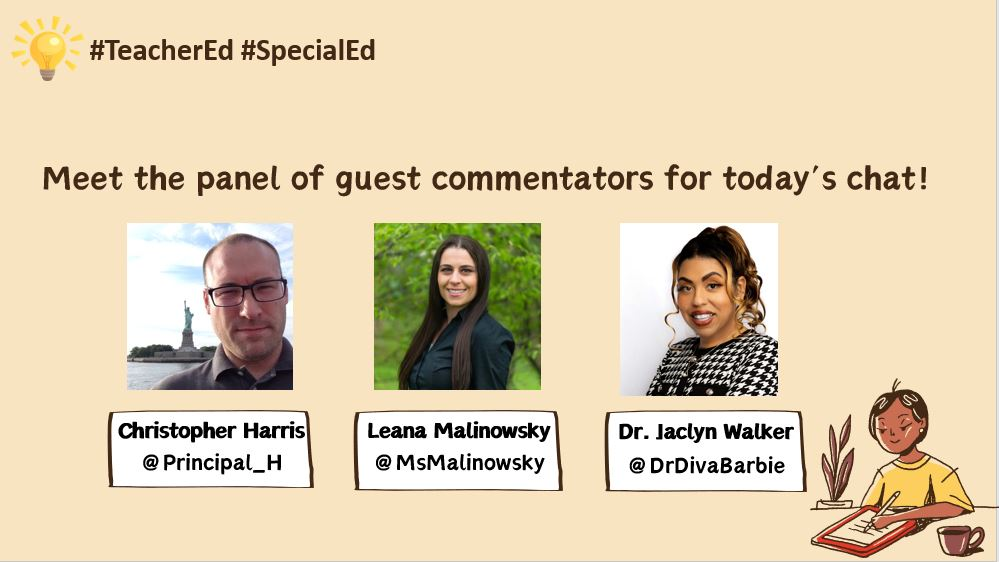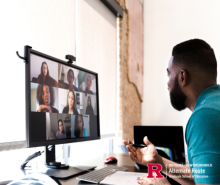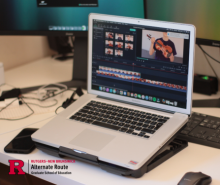Navigating Inclusion: Insights from New Teacher Social Media Chat

Creating an inclusive classroom environment is required of all teachers, but continues to be a multifaceted challenge, especially for new teachers. As educators strive to accommodate diverse learning needs, the journey often calls for innovative researched-based strategies, empathetic approaches, and collaborative efforts. Recently, Rutgers Alternate Route coordinated a digital exploration of inclusion students with learning disabilities through an engaging social media chat, illuminating the trials, triumphs, and transformative practices in supporting exceptional learners. The chat served as a dynamic platform for new teachers enrolled in the program to share experiences and exchange ideas, strategies and resources for enhancing inclusion practices for students with Individualized Education Programs (IEPs).
An esteemed panel of educators, seasoned in the art of serving students with diverse needs graced the virtual stage as guest commentators. They included Christopher Harris (@principal_H) a principal based in Pennsauken, New Jersey, who has been volunteering as a guest commentator for three years; Dr. Jaclyn Walker (@DrDivaBarbie) Director of Curriculum, Instruction & Assessment in Rivermont Schools in Virginia Beach, Virginia; and, Middlesex County Teacher of the Year Leana Malinowsky (@MsMalinowsky) who hails from Cateret School District.

Their wisdom and insights provided a compass for navigating the complexities of inclusive education. From differentiation to time management, classroom dynamics to resource constraints, the discourse delved into the heart of the matter, unraveling the challenges and opportunities that shape inclusive learning environments.
Challenges as Guideposts: Key Insights
The social media chat unveiled a vast range of challenges encountered by educators striving to foster inclusive classrooms. From differentiation and accommodations to time management and classroom dynamics, candidates identified common hurdles and a commitment to searching for actionable strategies to support their inclusion efforts.

Differentiation and Accommodations
The cornerstone of inclusive education, differentiation and accommodations emerged as formidable challenges during the chat. Participating teachers expressed that they frequently grapple with the task of tailoring instruction, assignments, and assessments to meet the diverse needs outlined in IEPs and 504 plans. Here is a sampling of responses extracted from the chat.
"At the beginning of the school year it was difficult to differentiate students with learning difficulties, but challenge was to make modifications for them to help in their needs." - @malvarado8504
“My greatest challenge has been pacing my lessons with differentiation in my lessons to make sure that all my students are progressing and successfully completing their projects so that no one feels left behind or left out." - @AlversonK1918
"Finding the balance between honoring the student's IEP goals and scaffolding so they can receive support but also foster independence. It can feel overwhelming at times creating differentiated work to show student's progress with skills and tiering the work"- @MsMalinowsky
"One of my biggest challenges is trying to use IEP accommodations for each one of my students while keeping a high rigor and independence. Because many of my students require a small group setting it also been difficult accommodating "small group" without running out of time" - @elliechase00
Time Management
Managing time effectively emerged as a pressing concern for the teachers. Striking a harmonious chord between attending to individual needs and catering to the collective progress of the class posed a delicate balancing act. Also, of concern was balancing support for independence for students with IEPs versus over-reliance on the teacher. The comments below illustrate the time management challenge.
"One challenge is that it is very time consuming to differentiate for a wide variety of abilities, but leveled groups and center-based work helps to mitigate." - @jessktran
"For me one of the most difficult challenges would be managing my time working with 7 students, each with learning disabilities while also allocating time for the other 12 students throughout the lessons. Always brainstorming what else can I do..." - @BarbaraA2424
"One of my biggest challenges is trying to use IEP accommodations for each one of my students while keeping a high rigor and independence. Because many of my students require a small group setting it also been difficult accommodating "small group" without running out of time" - @elliechase00
"Some of the challenges that I have had when trying to create an inclusive learning environment for students with learning disabilities is managing my time to do so, in the 40 minutes that I have for class." - @FloydWilliams
"In my case, as a teacher who pushes into classrooms, my time and resources are not as extensive. So, I have a limited time to make an impact...." - @ioannasoprano
"I find it challenging to manage my time in a way that serves the gen ed students in my class while also giving the #specialed students the time and attention they deserve. I often spend most of my time just with the special ed students." - @LS89672574
Classroom Management
The chat illuminated the challenge of navigating complex classroom dynamics as educators discussed encountering the dual challenge of managing distracting behaviors while nurturing an inclusive environment conducive to learning. Teachers like those below expressed concerns about keeping students on task, engaged, and respectful of fellow learners.
"Behavioral issues in the classroom by one student may disturb other students. Balancing that is challenging and the opportunity I have is to be fair to all students by working with them individually and collectively based on the lesson plan." - @PratibhaRa11403
"One of the challenges I'm currently facing is creating minimal distractions. I have a student with a defiant attitude. I eliminate everything on their desk to get them to focus as much as possible & this particular student finds something else to distract them self with." - @cisneros_RUGSE
"My classroom is noisy by nature. Getting students to be quiet enough for me to instruct can be a challenge." - @dave_lockhart
"Challenges I met are having many kinds of disability with different types of accommodation needed in one class. like having hyperactive students with other students who can easily be distracted." - @KarmaGuirguis
Resources and Training
In the pursuit of inclusive excellence, insufficient resources and training emerged as formidable obstacles. The quest for specialized knowledge and support echoed across the social media platform, underscoring the need for comprehensive training and ample resources evident in the following teacher responses.
"Biggest challenge, I am not trained for special education. But learning about special education students in the alternate route program gives me an understanding of their needs and modifications that I can implement for my students." - @Beni31244099
"In my case, as a teacher who pushes into classrooms, my time and resources are not as extensive. So, I have a limited time to make an impact...." - @ioannasoprano
"Biggest challenge is my inclusion speak teacher who is unwilling to draft modifications to the assignments and lesson plans." - @ScotchandSoda
Student Factors
Several candidate posts highlighted student-centric factors such as the challenge of getting general education students to understand and accept the accommodations provided to students with disabilities. They also mentioned student social anxiety, low confidence, and difficulties with peer collaboration as challenges to creating an inclusive classroom environment.
"For example, I have some ISP students in my Business class who are autistic. They can be very socially anxious. For communication assignments, I gave them alternative assignments before having them do mock interviews with me as their partner!" - @mi18910
"Often students with learning disabilities ask great questions that benefit the whole class. The challenge is to create an environment where they feel comfortable doing so." - @ruthsjim
"The challenges I have encountered when creating an inclusive environment is the peer collaboration. They tend to prefer to work alone and get the work done, but I want to push for more group work." - @naddhyax_
"A challenge is that gen-ed students often need to be reminded that equity exists and that everyone needs different things. Especially with incorporating modifications and accommodations in class." - @holdenmythought
Seeds of Success: Strategies in Action
Amidst the challenges, the teachers sowed the seeds of success through various strategies aimed at nurturing student growth and fostering inclusive environments. From differentiated instruction to small group support, multi-modal lessons to scaffolding and feedback, each strategy served as a catalyst for student success.

Differentiated Instruction
Empowering students with diverse learning needs, new teachers are embracing a variety of strategies ranging from extra time and manipulatives to choice-boards and multi-sensory experiences.
I really like to color code instructions and ... categories to help the students' organize their ideas better." - @Meaghan81513938
"In my PE classes I will provide different activities and have equipment that will support students' individual needs." - @ThomasGior37575
"I like to teach them several ways that they can use. I like to use manipulatives within the lesson and allow for students to partner up and work together." - @ranamsayed
"For assessments in math I let my students use manipulatives." - @MsMalinowsky
Small Group Support
Harnessing the power of personalized attention, many teacher responses revealed they are leveraging small group settings to provide individualized support and foster collaborative learning.
"For both of these subjects my struggling students and students with IEP's spend these subjects in small groups. This helps them not only focus but gives them more one-on-one assistance."* - @cisneros_RUGSE
"I employ multi-sensory teaching, clear directives, and visual aids to support K-1 students with autism, ensuring meaningful engagement through differentiation." - @MrsTowns18
"Really just through differentiation right now. Trying to give them a smaller group learning experience to help them stay focused and to help comfort with asking questions." - @MrcoakleyT75487
"I support students by giving them modified assignments and assessments, extended time, preferential seating, individualized feedback, frequent brain breaks and working in rotated small groups." - @jackievannatten
"You can create opportunities by finding ways to incorporate a small group setting, using different manipulatives, and giving students opportunities to move throughout instruction." - @elliechase00
"I provide as much individual and small group support as possible during assessments so I can apply the students' accommodations that are in their IEP and 504 reports." - @MsMalinowsky
Multi-Modal Lessons
Several new teachers discussed the importance of engaging students through diverse modalities by infusing lessons with movement, music, and visual aids, catering to varied learning preferences.
"As a Spanish teacher, I always have it at my disposal to teach vocabulary and other information in Spanish. I use books, photographs, magazines, and I have several links where we can find great content that includes helping students improve their Spanish." - @Silviag00001234
"Using visual aids, running lab experiments, model-building activities like building atoms, and hands-on activities like coloring the pH scale for bases and acids. Assessments can be chemical to run a lab with and tell their observations and conclusions." - @KarmaGuirguis
"Using visual aids to provide clear instructions and providing audio options for text passages can be helpful in an ELA classroom." - @AlexandriaLynn_
"Science classes can be difficult for students with disabilities because of terminology, but I like to offer visuals and videos. Assessments will always have images so they can understand the questions better." - @naddhyax_
"My content area is Spanish. I like to use group and partner projects. I also use online resources for listening and speaking practice to give them different learning media." - @TestB88
Scaffolding and Feedback
Guiding students on the path to mastery, some teachers discussed how they scaffold assignments, provide clear guidelines, and offer timely feedback to nurture the growth of their students with learning disabilities.
"Continue to provide scaffolding and support with a gradual release model in mind. I often rotate between assignments, and I'll provide support with one, then the next one let them try on their own so they can see where they need to improve."* - @MsMalinowsky
"In Kindergarten math I like to use a lot of manipulatives that are hands on. I like to let students explain their answers if they are incorrect before marking it wrong so that I can guide them in their learning." - @isa_shoe29897
"As an orchestra teacher I arrange the parts of the song with repeated notes or rhythmic patterns so students can learn the concepts without feeling the pressure of learning a whole piece with different sections." - @elmichi89
"Provide them with feedback on assignments in work when I meet with them individually, or I'll write it on their homework to review as well. Feedback is key to helping students realize where their strengths and area of grow are." - @MsMalinowsky
Accommodations and Modifications
Responses reveal that many teachers remain committed to equity and access, as they are prioritizing implementing the accommodations and modifications outlined in IEPs and 504 plans to ensure every student has the support they need to thrive.
*"My classroom environment is set (furniture cannot be moved). I use modifications (assignments and/or assessments), adaptable to the student's need, in addition to accommodations (usually time-related). I try to be flexible with the latter." - @victor_jac20662
"The opportunities that I have created in my art class to assist students with disabilities is by modifying requirements for projects, encouraging creativity from their own perspective and giving them positive reinforcements." - @MargaretGi89087
"... Understanding the IEPs and 504 of each student and creating modifications and accommodations based on that." - @PratibhaRa11403
"For reading we use learning ally- designed for a key population. In addition, read out louds to students. Extra time is given, breaks etc. whatever IEP says." - @KParagios
"I can modify and accommodate my students no matter their needs because the beauty of teaching science is the lab component. If they cannot learn audibly or visually maybe they can learn kinetically." - @ApekshaP16
Building Relationships
A few teachers noted the importance of cultivating a culture of trust and belonging to foster a safe and supportive learning environment for the students with learning disabilities. Their efforts to forge meaningful connections with students are captured in the posts below.
"This is a question I continuously think about. I am sure to always welcome students in the room that might have trouble participating in the classroom due to their perceived ability. Students that have accommodations don't always want to access them and I am deliberate."* - @tiredteacher57
"I can create opportunities by giving different modifications such as extra time, checklists, extra reminders, etc. Also, most important, using my ability to create rapport with the student so there is trust which will make implementation easier." - @Jayyy12322
Home-School Connections Conclusion: Charting the Course Forward
A final suggestion from the exchange is to bridge the gap between home and school. Several teachers highlighted the ways that they extend learning into students’ homes by collaborating with parents, providing resources and support to reinforce learning beyond the classroom.
"I often will make videos to help students practice their music at home if they are struggling with reading comprehension or are taking longer to learn the music in class."* - @AltRouteKDJ
"Posting clear guidelines, conferring frequently, partnering students strategically, working closely with parents to reinforce and support learning at home." - @LS89672574
Conclusion: Charting the Course Forward
At the close of the social media chat, candidates left with more than 200 actionable strategies to support their inclusive teaching practice. The collective resolve of our new teachers to champion inclusivity is clearly unwavering. Their transparency and shared insights reveal a confident cohort of new teachers poised to chart a course towards a more inclusive educational landscape, where every learner can thrive.
To explore the conversation or contribute your insights, search "#TeacherEd #SpecialEd" on the X platform or check out our Wakelet that curates the chat.
Also, check out our previously published blog posts addressing this topic.
• 11 Articles to Help New Teachers Build Inclusive Classrooms for Special Education Students
• How New Teachers Can Support Special Education Students in General Education Settings
• 29 Resources Special Education Teachers Use to Help Students Learn
• 39 Peer-Recommended Resources for Special Education Teachers
• 12 Free EdTech Apps For Special Ed Alternate Route Teachers
• NJ Alternate Route Teachers on Meeting the Needs of Special Education Students
• Facts and Resources to Better Serve Students with Autism

 Sharlene Laud has extensive experience in education from K-12 to higher education and holds a Doctorate in Education from the Rutgers Graduate School of Education. Dr. Laud is the Assistant Director of the Rutgers-GSE Alternate Route Program in the Department of Learning and Teaching. Follow her on X @sharlene_laud
Sharlene Laud has extensive experience in education from K-12 to higher education and holds a Doctorate in Education from the Rutgers Graduate School of Education. Dr. Laud is the Assistant Director of the Rutgers-GSE Alternate Route Program in the Department of Learning and Teaching. Follow her on X @sharlene_laud





